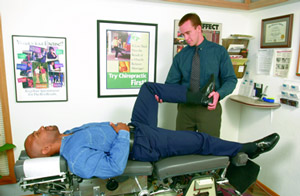Sciatica and the Chiropractic Lifestyle
An all too common health complaint.
The sciatic nerves are the largest (and longest) nerves of the body,
reaching about the size of your thumb in diameter, and running down the
back of each leg. When these nerves are irritated or affected by the
inflammation of nearby soft tissues, doctors refer to this as sciatica.
One of the most common causes of sciatic leg pain is the Vertebral
Subluxation Complex. It can be accompanied by the bulging or herniation
of the soft pulpy discs which separate each spinal bone. This can
irritate or put pressure on the sciatic nerve roots as they leave the
spinal cord. The result can be an intense pain shooting down either or
both legs.
In the past, treatment has involved pain medi-cations, muscle relaxers,
physiotherapy, and even surgery. The chiropractic approach is to use
carefully directed and controlled pressure to remove the interference
from spinal structures. These chiropractic adjustments can be quite
effective in reducing nerve irritation and its associated pain.
Sciatica, like other health problems that can be traced to the spine,
often respond dramatically to the restoration of normal spinal function
through conservative chiropractic care.
Research shows that when treated with chiropractic adjustments, sciatica has an 8-9% greater rate of recovery than if patients were to use therapy or standard medical care.
 The largest nerves of the body.
The largest nerves of the body.Pain is caused when the sciatic nerve roots are irritated, scraped, twisted, stretched or pinched as they exit the spine. Causes of the impairment may be chemical, physical or the emotional stress of everyday living. A full-blown sciatic flare-up can involve the entire sciatic nerve path resulting in symptoms of lower back pain, burning, cramping or numbness that radiates into the thighs, legs, ankles, feet and toes. Pain may also be limited to various points along the nerve, such as the buttocks, knee area and calf.
Chiropractors are experts in the care of the bones, nerves, muscles and connective tissues that make up about 60% of your body. All of the joints in your body are part of this musculo-skeletal system and its optimal function is necessary for overall good health. Ask your Doctor of Chiropractic for more information about a care program that may include specific spinal adjustments, exercise recommendations, nutritional advice or other conservative methods of care based on your health history, age, current condition and lifestyle.
Gray, H., 1827-1861, Grays Anatomy, Williams P., Worwick, R., Editors, 37th edition, Churchill Livingstone, 1989, Reprinted 1993.
Kirkaldy-Willis, W., M.D., Managing Low Back Pain, 3rd edition, Churchill Livingstone, 1993.
Kur, F., Loh, C., Treatment of Lumbar Intervertebral Disc Protrusions by Manipulation, Clinical Orthopedics, 215-47, 1987.
Manelfe, C., M.D., Imaging of the Spine and Spinal Cord, Raven Press, 1992.
Memmler, R., M.D., Structure and Function of the Human Body, 5th edition, J.B. Lippincott Company, 1992.
Moore, K., The Developing Human: Clinically Oriented Embryology, 3rd edition, W.B. Saunders Company, 1982.
Nwuga, VCB: Relative Therapeutic Efficacy of Vertebral Manipulation and Conventional Treatment in Back Pain Management, AM. Phys. Med., 61:273, 1982.
Shekelle, P.G., Adams A.H., Chassin, M.R, Hurwitz, E.L., and Brook, R.H. Spinal Manipulation for Low Back Pain. Ann Intern Med 1992; 117:590-8.
Rothman, M.D. Simone, M.D., The Spine, 3rd edition, W.B. Saunders, 1992.
White, A.A., M.D. and Panjabi, M.M., Ph.D., Clinical Biomechanics of the Spine, 2nd edition, J.B. Lippincott Company, 1990.
(800) 937-3113 (303) 277-9990
www.backtalksystems.com

